DIY Built Solarpanel Installation Now Operational
Posted by Chris van der Zwaal in Solar energy 19 Comments» Last spring (2009) I wrote my first article about building my own solar panels (just to be clear : for making electricity) . At the end of the day on December 31, 2009, I had finished installing my panels totalling about 400 Wp. So now its time for an update.
Last spring (2009) I wrote my first article about building my own solar panels (just to be clear : for making electricity) . At the end of the day on December 31, 2009, I had finished installing my panels totalling about 400 Wp. So now its time for an update.
The Solar Cells
The installation is made up of 8 panels, 27.5 x 40 inches each. The panels are made with solar cells, size 6 x 6 inches. I estimate the power of the panels to be 50Wp (or slightly higher) each. These cells were new and unused, lying somewere on a shelf in a warehouse, almost forgotten. I got them pretty cheaply (around $ 0.62 per Wp), understandibly because the efficiency is only 9 %. And that, these days, is considered very low.
Transmissivity of Glass
After my article from last Spring, I have done a lot of research: the transmissivity of the glass especially kept me busy because the transmissivity of ordinary glass was very poor. To be able to measure this transmissivity, I built a test panel. I made 2 “strings” of 12 Evergreen cells (by “string” I mean cells connected in series). The picture shows these 2 “strings”. If you look carefully, you can see 2 different pieces of glass in front of it.
Without glass in front and in the sunlight, I connected each string to its own multimeter to measure its respective shortcut current. Of course, that gave different values (the multimeters as well as the strings are not equal). So by interchanging the multimeters, I got 2 measurements and averaging those 2 values gave me a pretty accurate figure of the difference. The next step was to put a piece of glass in front of only one of the strings and leave the other string without glass in front. I took a measurement and recorded it. Then I placed the glass in front of the other string and again recorded the measurements. I had to repeat these steps, but now with the multimeters interchanged. This way I got 4 measurements and by averaging these, I got a pretty good and accurate result about the influence of the light transmissivity of the glass on the shortcut current. Of course this does not measure the maximum power point of the cells, but I assumed that the result about the transmissivity will be the same. It would not be logical if it would be different. So now I was able to test the different sorts of small pieces of glass that I had gathered. In the end, I chose the most economical glass. Ordering it in a relatively large quantity of slightly more than 1000 square foot, I got it for a very acceptable price. It is 0.12 inches thick and it is tempered! The price: $ 1.90 per square foot. Of course I am not going to use it all for myself but I sell it to other DIY solarpanel builders. This way they can take advantage of my low price and also know they get tempered glass with a reasonable transmissivity. The ordinary glass measured below 80% compared to my tempered glass, which is about 90%. So now I have glass with a very acceptable transmissivity, it is tempered, and the price is pretty low! At that time I already had the 6 x 6 inch cells (they have a different size than the Evergreen cells requiring another size of glass) So part of the delivery of glass were about 40 pieces with the right size for my panels. The other 2 sizes are for Evergreen panels with 36 or 72 cells each.
The Installation Ready and Fixed to My House
On the night of December 31st, my solar panel installation was ready! The only thing to do was sit and wait for the sun, and I was lucky because the next day, the first day in the new year, it was a full sunny day. Being a day with not many daylight hours and a sun at its apex only 15 degrees above the horizon, my installation worked like it should. The first day maximum was 265 Watt of electricity “pouring” into the grid through the gridtied-inverter. The panels are almost exactly oriented to the south: 175 degrees on the (true) compass. So that is about as good as can be. The tilt of the panels is somewhat steeper than optimum for the whole year, which is around 32 degrees. I had mounted them at about 50 degrees. This is far better for the winter season as the sun is so low on the horizon. I have plans to alter the angle around April or May to accomodate for the higher apex of the sun during the summer. With my construction that will not be too complicated to do. You might be able to understand this when you look at the picture.
And This Is What It Looks Like
Some Figures and Measurements
The cells are a lot bigger than the Evergreen cells which are about 3 x 6 inches: they measure 6 x 6 inches, so they are twice the size. But as their efficiency is 9% (Evergreen cells: 14%) their output is not double, but around 55% higher. I calculated the Evergreens to generate 1.5 Wp each (placed behind the glass) so these cells must be 1.5Wp x 155% = 2.32Wp. I have 24 cells in a panel (size 27.5 x 40 inch). That gives 24 x 2,32Wp = 55,68 Wp per panel (for now I will consider them 50Wp each to have a conservative assumption). I now have 8 of those panels and they are all connected in series. They are feeding a Philips 500 gridtied-inverter (it is second hand and it is a predeccessor of the Stecagrid 500 commonly used in the Netherlands, being most presumably the same). So I have 8 x 55,68 = 445 Wp. For now I will consider it 400Wp.
Of course, I will not see this high output for some time to come, but as the sun starts to go higher above the horizon my output will also rise. That indeed is what is happening : on January 1st, I got a reading of 265 Watt, but as the days progressed (waiting each day for sunlight but most days were cloudy all day) the readings got higher indeed. So far my highest on Februari 3th was already 373 Watt !! And that is very promising.
The temperature of the cells probably was below 77 Fahrenheit (25 celsius) which is the temperature at which solar panels are tested and measured to give their WattPeakPower. With higher temperatures, this output decreases considerably (and of course at lower temps the output is higher). Roughly 1% per 4 degrees Fahrenheit (or 1% per 2 degrees Celsius). So at approximately 131 F ( 55 C ) the output is around 15 % lower. The temperature of a solar panel can go way above this temperature.
The reason that the sunlight is weaker when the sun is low on the horizon is that the light has to travel a much longer distance through the atmosphere and then a lot of energy is lost. One can calculate the comparison between several angles above the horizon. You simply compare the sinus of 15 degrees and the sinus of 20 degrees and then compare these two : sinus 20 / sinus 15 = 0.342 / 0.258. The funny thing is, and I did not expect this, the readings I got from 15 degrees (on Jan. 1st) and 20 degrees (on Jan. 28th ) are 345 Watt / 265 Watt. This is about the same ratio.
What I also did was measure the voltage and current coming out of the panels into the inverter. Multiply these figures and you get a very accurate figure about the Watts that the panels produce. Now compare this figure with how many Watts the inverter is “pouring” into the grid. Look at the picture below to see these measurements. It is a simple calculation to find that the efficiency of the inverter is about 95%, but it is not accurate as the powermeter that I use surely does not take into account any phase shift that will be there between current and voltage. I just have to assume that within certain limits it is correct, but those limits probably are “wide”.
Picture of the Voltage(87.1) and Amperes(3.02) (Input-Side of the Inverter) and Power (251)(Output-Side of the Inverter)
If I take my highest reading of 345 Watt and correct it for this 95% I get the power that the panels made at that moment : 363 Watt. I have high hopes that I will see readings of higher than 400 Watt and then I can be very content. It would mean that (after correcting for the inverter) the panels are well above 400 Watt. The power meter is a simple one. I bought 2 of them. I opened one of them to internally switch input and output. I thought that it would be nescesary because the current in this situation flows in the other direction through the powermeter. However, I found that the “un”modified powermeter worked just as well. Of course this does not mean that it applies to all other types of powermeters.
The Cost of My Panels
I have calculated that the cost of one panel is around $ 83.00 (at the present rate of 1.39 dollar to the euro). My aim has been to get a panel for € 1.20 per Wp. I express this in euros as the rate of the dollar is changing so often and I live in an euro environment. But this € 1.20 at present equals $ 1.68 per Wp. Well it seems that I have reached that goal. But I must say that I have been rather conservative with this aim to prevent disappointments. Nice thing about this is that I will probably even go below this aim! If and when my panels produce 400 Wp I will have reached my goal, but right now it is very likely that I might even go 10% higher. So my price per Wp will be below € 1.10 or $ 1.51 per Wp. In this situation, my panels are 55 Wp each. But I must honestly say that I did not take into account the extra cost I had for buying some extra tools. On the other hand , building more panels will reduce that influence. And that brings up the next chapter.
Plans for the Future
It is a lot of fun doing this project and I have started preparations for building another 8 panels. My final goal is to make 40 of them. As you can see on the picture, my present home will not be able to accommodate many more panels, so I am very glad that I am going to buy a new home with lots of space to place the panels on the ground in my far backyard .
Some more remarks.
The panels are made exactly according to the double glass principle that I described in my first article. For some more detailed info I have a second website: http://doctersnuggles2.come2me.nl
I had hoped to have my installation ready last summer but gathering and choosing the right materials took a lot of time. It was important to do and it was worth it. Hopefully it helps to make the panels last a lot of years and that in itself will hopefully take a long time to prove. The choice of the glass especially took a lot of time.
By selling cells and other important materials for building a solar panel, I got a lot of extra ideas from others, and that was one of my aims. I got in contact with quite a few do-it-yourselvers and we exchanged a lot of information. That also resulted in a forum for “do-it-yourselfers” but it is in the Dutch language. The fact that it is there indicates that there are enough others building solar panels.
Possible Improvements
Talking about different ways to build a solar panel, I can say that there are about 5 others developing/finding a way to use EVA lamination to completely seal the cells. This is also the material that is being used by most solar panel factories. Through my contacts I have been lucky enough to get some of this EVA. It is past its expiration date, but tests have shown that it still works fine. If they succeed in finding a simple way to apply/use it, then I will start using their method too for future panels. The efficiency of the panel will increase (according to some internet articles) if the air gap between the cell and the glass is removed and replaced by this lamination. As the air is not there anymore the lightrays will have less (strong) transitions (air into glass – glass into air – air into the cell). Also the reflecting between the front of the cell and the backside of the frontglass will be less. The efficiency of the panel in this way can rise from 90% up to 95% . Read also the comments about this in my first article.
Chris van der Zwaal
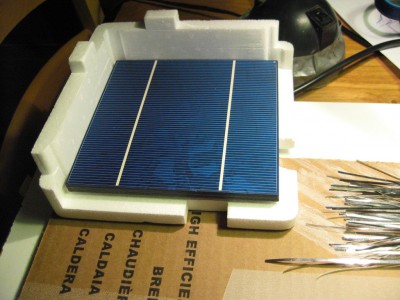
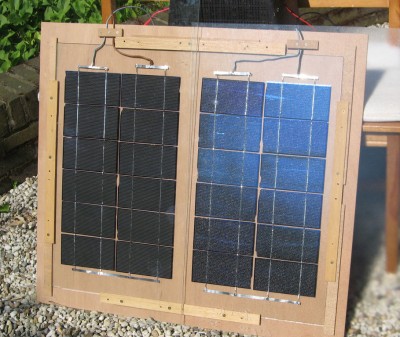
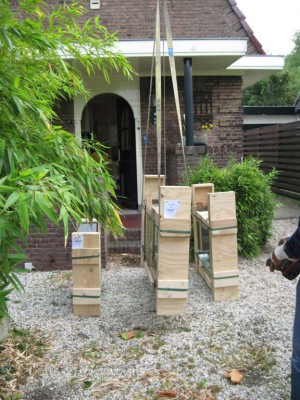
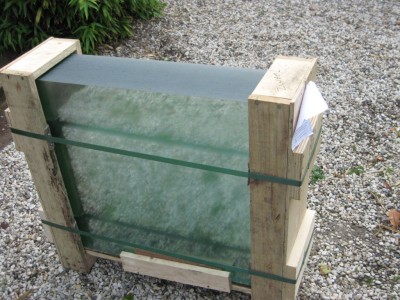
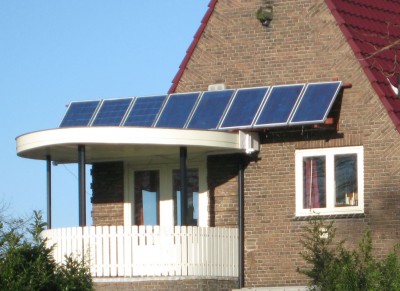
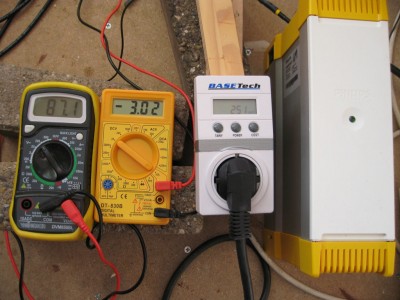





19 replies on “DIY Built Solarpanel Installation Now Operational”
Very nice and informative. I read through your articles and your two websites in one go. I am compelled to appreciate your interest and street smartness in buying glass in bulk and sell the excess of them so as to save a decent amount.
That apart, you sounded much like an engineer, and much more than any other do-it-yourselfer. They way you experimented to measure output wattage with different glass and no-glass setting was nothing short of a kind of calibration.
However, the only drawback with your article is the best part of the second one is in a language I couldn’t understand despite the images of solar panels and its construction images. Being an engineer myself, I could read something into the photos looking at the solar cells and multi-meters, but not always the pictures speak 1000 words, you know? In my view, a video guide, explaining the critical steps to build solar panels would help a lot better.
It is really interesting to see what you think about my comment, so, I keep my fingers crossed in wait.
Hi,
Thanks for your compliment
I am a very busy person. Thats the reason why I made the mistake of changing the language to Dutch (I live in the Netherlands) , I am just too busy……sorry for that. And making a video is just too much for me to accomplish right now…. I do have in mind ( on my mental list…) to change the language….. I just dont know when I can find the right moment for that
I am building similar panels in Nepal. I ordered the Evergreen cells from the US. I am running into a problem finding good glass though. Would you be more specific about what type of glass you found. Is it greenhouse glass, ultra clear low iron glass? I also worry about the thickness of the glass effecting the transmission. 5 mm seems very thick.
Hello J Prokos.
Sorry for being so late with my answer.
I use greenhouse glass. It is tempered , 3 mm thick . The with my 3 mm glass the thickness is cause of only half the “resistance”to the light. The other half is caused when the light leaves the glas and goes into the air. I think they call it refraction.Not sure. In holland there are a lot of greenhouses and thus it is not so difficult to find it. And offcourse I ordered a large quantity and then resold 2/3rds.(so I got a relatively low price )
I don’t know why you speak of 5 mm but you probably want to use that because you cannot find tempered glas and you want it to be strong.
Regards ,
Chris
i have perchage a solar system at 5kw so what is the prise of this system
My price is about E1,60 per Wp for the complete system including the (secondhand) inverter, cables , mounting , everything included !
And it can be done cheaper still……
I have moved my panels to a new adress. 12 panels are finished now.
I have a much cheaper mount to put the panels on ( second hand material ) And I have done a recalculation of my cost of the total system :
E 1,35 per Wp………………….
Dear sir,
i am planning to install solar system in my house . kindly advice where to purchase and other contact details.
Thanking you,
G.K.Mahendran.
Date: 01.07.2010
sir i am from india kindly suggest me how to implment the panel in my house and also tell me the expenses, because i am planing to impement in poor villagas mainly ,waiting for ur reply
Hello Chris,
please help me build my 100watt solar panel, can you give me list of equipment i need to be able to build solar panel.
Thanks
Alex
Hello Alex,
I could not give you a full list because that would also have to include tools, and that would depend on the way you do things yourself.
But in general you need solar cells, the wires to connect them to eachother and a method to protect the cells from the environment. Almost all panels worldwide use tempered glass for the protection on the frontside (like I also do) But for further sealing of the cells they use lamination. But that is somewhat difficult for a do-it-your-selver. So I use the 2 plates of glass and in between them the cells. And making sure (as best as I can) that it is sealed very well so it will hold hopefully for many years.
Look on ebay.com (for solar cells) and you will find a lot of it and also the wires to cennect the cells.
I suggest that you first buy only a few cells to experiment and find out how to (very carefully !) handle them.
Also look on : http://pvcdrom.pveducation.org/index.html and study it . You will find a lot of good information there !
Regards , Chris
Hello Maruthi,
Your question is simple but the answer would be far to long for me to give. You will have to find someone closer to you in India who knows about electricity.
The cost for me have been E 1,35 per Wp for my 440Wp installation connected to the grid.
But for buying all parts new ( solar panels and also the grid-tied inverter) my costs would have been approximately E 2,70 per Wp.
Regards, Chris
Hereby an update about the behaviour of my system(also written this as comment with my first article) :
Well , the system works very good.
The output must be somewhat higher than that 400 W ,as the maximum that I have seen sofar was 57,5 Watt per panel (this was the power before it went into the gridtied inverter). So for the full system of 8 panels the outputmax. was not 400 but 460 Watt.
I am keeping track also of the total (yearly) powerproduction. And on june 22nd that total was (so you can say after half a year) 205 kWh meaning that for a full year it will be close to 400 kWh.
All these figures indicate that my panels are around 55 Wp (Most panels that are factory rated at a certain Wp-figure will during their lifetime sometimes produce a higher output than this factory rated Wp-figure, this is to explain why I do not rate them at 57,5 Wp)
And for now I have not seen any problems regarding the sealing of the panels.
My next series of 8 panels is almost finished and then I will start to use a more powerful inverter that I have ( SunnyBoy 1100) requiring the higher voltage of the total of 16 panels in series. I am talking about an outputvoltage of around 225 V DC. That is really becoming dangerous when the isolation is not allright….
By the way “doctersnuggles” in normal life is “Chris”
Hi Chris what about taking the back piece of glass and either painting it or tinting it so less refraction is produced by the sun.
Hi Tony,
I think it is better to have the frontside of the backplate reflect the sunlight forward and then reflect against the backside of the frontplate and in this way get (a little bit) more light on the cells.
Or perhaps I do not understand what you mean exactly…
Hi Chris, I was thinking in terms of that you said that the heat on the cells was the problem, so if you used some copper or something like that for heat dissipation, then blackout the back piece of glass to help dissipate the heat away from the cells, but as you say we like to keep as much sun going to the cells as much as possible hope this clarifies things and thanks for a site with very good info.
OK,now I understand what you were aiming for.
The cells do get heated during sunny and hot days. But I must say that I do not know if the celltemperature is that much higher than the cells from a factory made panel that has only EVA and TPE on the backside. The main thing is that the cells need to be in good contact with the glass (ideally front and backplate of glas) My cells are very near to the backplate , I guess less than 0.2mm. So the heat will transfer pretty good to the backplate. And glass is a pretty good conductor for heat :5 times better than EVA, but the glas is more than 5 times thicker than the EVA. Anyhow in practice I believe that the cells will get a somewhat higher temperature than in factorymade panels. But to me it is acceptable. Main thing is that the difference in temp between the front and the backplate of glas is not to big.(difference in expansion between the 2 plates) So far I have only touched it with my hand to feel the difference (and not really measured it) but the difference is such that it doesnt worry me.
Thank you for the comment and the compliment !
And maybe in the future I will experiment on building panels the factory-way: with EVA an TPE (I have both). But that requires building somekind of vacuum-oven. Someone else here in the Netherlands is working on that! I am in contact with him and I am waiting for him to work out something for that. I have given him an idea to start with and he is building on that idea.
Hi, where did you get the glas from?
no issues with broken glas?
regards, nick